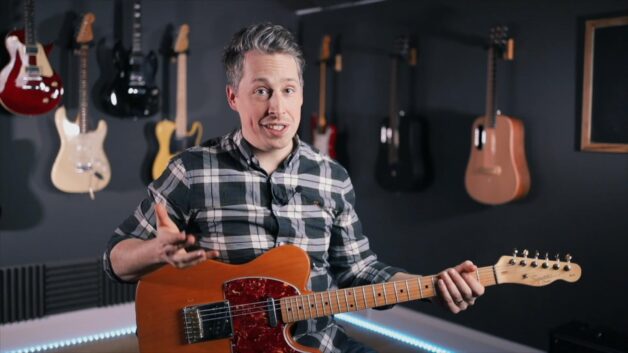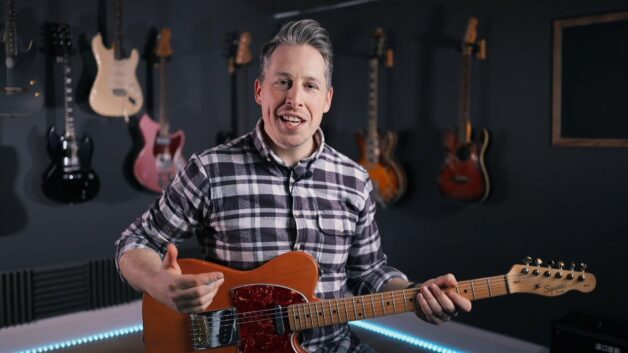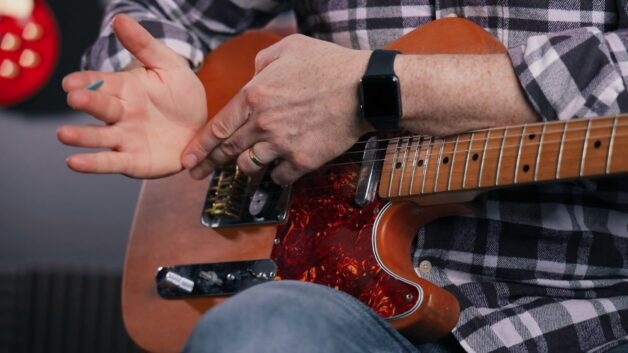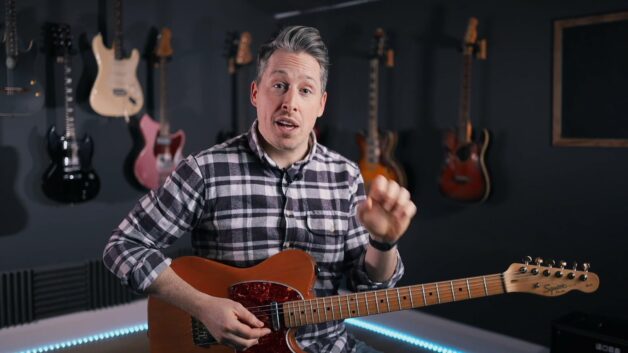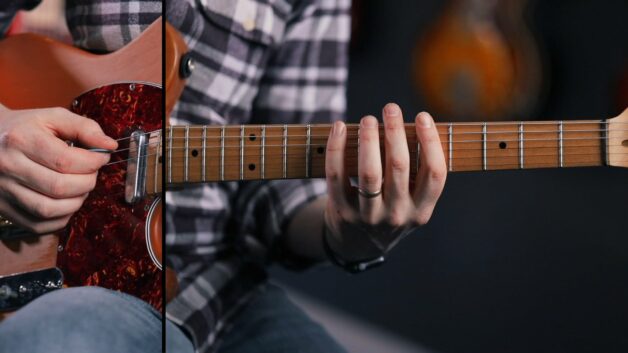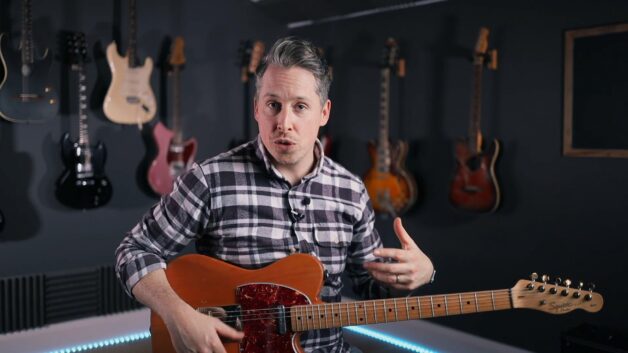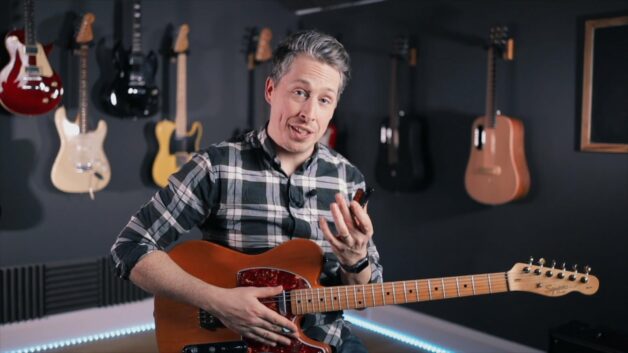Module 2 - Lesson 2
Introduction to Blues Guitar
 Julien Bitoun
Julien Bitoun
- Beginner
- Blues
-
MODULE 2
Introduction to Guitar Music Styles - Introduction to Folk Guitar
- Introduction to Blues Guitar
- Introduction to Pop Guitar
- Introduction to Rock Guitar
- Introduction to Metal Guitar
- Introduction to Funk Guitar
- Introduction to Jazz Guitar
Recommended songs
| Title | Album | Type | |
|---|---|---|---|
Boom Boom

|
Rhythm Guitar | ||
Cars Hiss by My Window

|
L.A. Woman | Guitar | |
Cocaine

|
Rhythm Guitar | ||
Crossroads

|
Rhythm Guitar | ||
Damn Right, I've Got The Blues

|
Damn Right, I've Got the Blues | Guitars, Bass & Backing Track | |
Dust My Broom

|
Guitar | ||
Further Up On The Road

|
EC Was Here | Guitars, Bass & Backing Track | |
Green Onions

|
Rhythm Guitar | ||
Hideaway

|
Blues Breakers with Eric Clapton | Guitar, Bass & Backing Track | |
Hoochie Coochie Man

|
Rhythm Guitar | ||
I'm A Man

|
Guitar | ||
Johnny B. Goode

|
Rhythm Guitar | ||
La Grange

|
Rhythm Guitar | ||
Mannish Boy

|
Guitars, Bass & Backing Track | ||
Riding With The King

|
Riding With The King | Guitars, Bass & Backing Track | |
| Road Runner | His Best | Full Score | |
Sloe Gin

|
Sloe Gin | Guitars, Bass & Backing Track | |
Sunshine Of Your Love

|
Disraeli Gears | Rhythm Guitar | |
Sweet Home Chicago

|
King of Blues | Guitar & Backing Track | |
Texas Flood

|
Texas Flood | Guitar, Bass & Backing Track | |
The Thrill Is Gone

|
Rhythm Guitar | ||
| Who's That Coming | Tattoo | Full Score |
How to Play Blues Music on Guitar: A Beginner’s Essential Guide
Why Blues Matters (and How You Can Master It)
Learning how to play Blues music on guitar isn’t just about mastering chords and rhythms; it’s about connecting deeply with a rich musical heritage. The blues isn’t merely a style, it’s the cornerstone of nearly every modern music genre you enjoy today, from rock and jazz to soul and even heavy metal. Yet many beginners find themselves quickly overwhelmed, uncertain how to capture that authentic blues feel.
If this sounds familiar, don’t worry: every guitarist, even legends like Eric Clapton or Stevie Ray Vaughan, started exactly where you are right now. Let’s unravel the blues step by step, taking the mystery out of what makes this music timeless.
Where Did the Blues Really Come From?
The blues originated among workers in the cotton fields of the Mississippi Delta shortly after slavery ended. Early blues artists like Robert Johnson and Blind Lemon Jefferson traveled from town to town, sharing their soulful, acoustic guitar style. Their simple yet emotive songs laid the groundwork for generations of musicians.
As industrialization shifted workers northward in search of better opportunities, the blues naturally moved with them. Chicago became a significant musical hotspot in the late 1940s, giving birth to electric blues. Musicians like Muddy Waters and Howlin’ Wolf electrified the traditional acoustic blues, creating the distinctive Chicago Blues sound characterized by amplified guitars, harmonicas, and raw emotion.
Interestingly, this very American art form found fresh life overseas during the British blues boom in the 1960s. Artists like Jimmy Page and Jeff Beck reinterpreted American blues classics, ironically inspiring American musicians to revisit their own roots. The cycle of musical influence turned full circle, sparking entire new genres like psychedelic rock and heavy metal.
Getting Down to Basics: Chords, Structure, and Rhythm
When learning how to play Blues music on guitar, beginners should first focus on understanding the fundamental structure. Most blues songs follow a clear, repeating pattern known as the 12-bar blues. This structure revolves around three essential chords: the root (I), the fourth (IV), and the fifth (V). To give you a practical example, think of classic songs like The Thrill Is Gone by B.B. King or Hoochie Coochie Man by Muddy Waters, which are perfect demonstrations of this chord progression.
A common mistake beginners make is rushing through chord changes without mastering the rhythm. Blues rhythm has a distinct triplet feel, where beats are divided into groups of three rather than the typical two or four. This subtle rhythmic distinction creates the “shuffle” feel characteristic of authentic blues music.
Tip for Beginners: Spend time practicing rhythmic patterns slowly, counting “one-trip-let, two-trip-let” aloud. Don’t be afraid of simplicity at first, solid rhythm foundations will carry you further than complicated solos.
Essential Techniques Every Blues Guitarist Should Know
Beyond chords and rhythm, certain techniques define the blues guitar style. String bending is perhaps the most recognizable; it allows guitarists to express emotion in ways similar to the human voice. When practicing bends, beginners often struggle with pitch accuracy, so always double-check by matching your bends to a fretted target note.
Other essential blues techniques include:
- Hammer-ons and pull-offs: These give your playing smoothness, helping you move between notes without excessive picking.
- Slides and vibrato: These add emotional depth and character to your playing.
- Palm muting and ghost notes: Crucial for developing dynamic rhythm playing, preventing monotonous or overly loud strumming.
- Using a capo: This tool shifts the guitar’s open strings to different keys, offering creative flexibility helpful if you’re struggling to play certain chord shapes.
Avoiding Common Pitfalls
Beginners frequently overuse complex techniques too soon, causing frustration and inconsistency. Remember, simplicity can be your friend. Great blues often revolves around minimal notes played with intention. Take it slow, master basic techniques first, and gradually introduce complexity.
Ready to Start Playing the Blues?
Exploring how to play Blues music on guitar takes patience and consistent practice, but understanding these basics puts you firmly on the right path. Now it’s your turn: grab your guitar, revisit a few classics, and immerse yourself in one of the richest musical traditions around.

